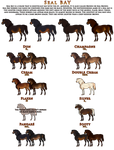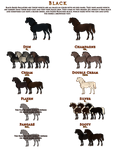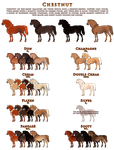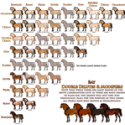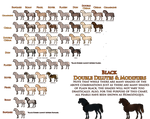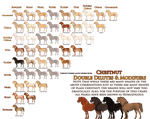Genetics
Introduction
In this list you will find the basic description for all the possible coats for Ballators, as well as some of the possible mutations. Read through these carefully, and feel free to refer to here for design reference!
Visit our Visual Guides for an even better idea of coat colors.
Table of Contents
Horn Genetics
Like the coats of Ballators, the horns have their own distinct set of genetics.
Click the button on the right to view the Guide on Horn Genetics!
Base Coat Colors
Equus Ballator coat genetics are largely based off of real life horse genetics, but due to genetics being a wide field, we take some artistic liberties to help people understand better!
———-
In Ballators, all horses are genetically one of three base coat colors: Bay, Black, or Chestnut. All other mutations, dilutions, modifiers, and genes will ‘sit’ on top of one of these three, and you get get some pretty interesting combinations!
- BAY -Ee Aa / Ee AA / EE Aa / EE AA / Ee AAt / EE AAt / Ee AtA / EE AtA
Bay also comes in two additional ‘forms’ – Wild Bay (E_A+) and Seal Bay (E_At)
Bay horses range in shade from deep red to a lustrous brown and any shade in between – but they will always have dark manes and tails and dark points – that is, ear tips, lower legs, and muzzle.
Wild Bays appear as normal bays, though some can be a lighter, more light golden-brown, and they will only have black/dark fetlocks and/or knees, in addition to the dark mane, tail, ear tips, and muzzle.
Seal Bays are darker than normal bays and will have lighter underbelly, flank, muzzle and other soft areas. - BLACK – EE aa / Ee aa
Characterized by a black coat with no hints of natural red; blacks may sunfade, turning parts of their coat a reddish or coppery color, but this is bleaching from the sun and not a natural color. Black horses will have dark skin. - RED (Chestnut) – ee aa / ee Aa / ee AA / ee Ata / ee A+a
Chestnuts can come in many shades – bright copper, sandy, ‘classic’ brown, or dark liver. Black chestnuts appear as black horses but still retain a reddish hue. Chestnuts will have greyish skin.
Dilutions & Modifiers
A dilution or a modifier gene does exactly what the name implies: it dilutes or modifies the coat! The list of dilutions & modifiers are Cream/Double Cream, Champagne, Pearl/Cream Pearl, Dun, Silver, Flaxen, Pangare, Grey, and Sooty.
There are a wide variety of combinations of Dilutions and Modifiers, so it would be impossible to make a guide that contains all of them! A horse can have multiple dilutes/modifiers acting upon it’s coat; in this case, we call such horses double dilutes. We have put together Double Dilute guides for each of the three base coats, with an included Seal Bay guide; while there are only two combos per coat here, if your horse has more than that, you can often get the general idea of what your horse will look like by looking at these guides!
NOTE: The below sections are image-heavy and any clicked image will take you to DeviantArt!
CREAM – nCr / CrCr
Cream does what the name sounds like it should do – it lightens the coat, like adding creamer to coffee. Double/Homozygous cream horses (CrCr), no matter what the base coat, all look nearly identical and will have pink skin. Black based horses, when they have a single cream gene, can look completely normal or be slightly more brown in color.
HETEROZYGOUS (nCr)
- Bay + nCr = Buckskin; golden , golden-yellow, or light cream colored body with dark points and dark mane and tail.


- Seal Bay + nCr = Seal Buckskin: Darker than standard buckskin, taking a brown shade; lighter soft areas (underbelly, flank, muzzle, around eye); dark mane/tail and points.


- Wild Bay + nCr = Wild Buckskin: May be lighter, yellower, or more tan than normal buckskin; points will be dark and confined to the fetlocks and/or knees. Mane and tail will be dark.


– - Black + nCr = Smoky Black; black may appear completely normal or may be slightly brown in shade.


– - Red + nCr = Palomino; golden or light yellow colored with a light or white mane and tail. Alternatively, they can have a shade called ‘chocolate’ where they appear much like a liver chestnut.


HOMOZYGOUS (CrCr)
- Bay + CrCr = Perlino; creamy, or off-white base coat; may have slightly orangy/tan mane, tail, and points. Pink skin.


- Seal Bay + CrCr = Seal Perlino; may be slightly darker than normal Perlino. Light soft areas, darker mane/tail and pink skin.


- Wild Bay + CrCr = Wild Perlino; darker points confined to the knees and/or fetlocks. Darker mane/tail and pink skin.


– - Black + CrCr = Smoky Cream; Creamy Tan, beige, or off-white base coat; mane/tail may be darker or identical to the base coat color. Pink skin.


– - Red + CrCr = Cremello; White or creamy coat with white mane/tail. Pink skin.


PEARL – nprl / prlprl
Pearl horses have a shiny coat that is diluted to a warm, golden-tan color. Pearl horses have muted pink skin and can have freckles on the skin; manes and tails will be close in color to the base coat. Pearl will be carried unless it is dominant, or combined with cream (explained later on!)
- Bay/Seal Bay/Wild Bay + prlprl = Bay/Seal Bay/Wild Bay Pearl – horse will retain some dark pointing, but these will be more of an apricot color. All bay variants + pearl look identical, except Seal Bay pearls will have lighter soft areas and Wild bay pearls will have dark points confined to the fetlocks and/or knees.


– - Black + prlprl = Black Pearl – horse may be slightly darker that other pearls, but will appear more or less identical.


– - Red + prlprl = Chestnut/Apricot Pearl – horse will appear as a typical pearl.


CREAM PEARL – Crprl
Cream and Pearl are on the same locus – or, in easier terms, in the same ‘color family. A horse can inherit one copy of cream and one copy of pearl from it’s parents, creating a cream pearl.
- Bay/Seal Bay/Wild Bay + Crprl = Buckskin/Seal Buckskin/Wild Buckskin Pearl; very similar to Pearl counterparts; will be slightly lighter.


– - Black + Crprl = Smoky Black Pearl; very similar to pearl counterpart, but may be lighter.


– - Red + Crprl = Palomino Pearl; very similar to pearl counterpart, but may be lighter.


CHAMPAGNE – nCh / ChCh
Champagne causes a ‘dulling’ and lightening of the coat, while giving it a certain sheen. Champagnes will have pinkish-grey skin with freckles. Homozygous and Heterozygous examples appear identical.
- Bay + nCh/ChCh = Amber Champagne; causes an almost buckskin-like color to the coat; points are turned a reddish-brown or chocolate color, with mane and tail taking the same type of shade.
- Wild Bay + nCh/ChCh = Wild Amber Champagne; identical to Amber Champagne, but with darker points confined to the fetlocks and/or knees.


- Seal Bay + nCh/ChCh = Sable Champagne; much darker than Amber Champagne; a deep grey-brown, almost purple shade will occur on the coat, with darker chocolate points and mane/tail. Soft spots of the horse will be light.


– - Black + nCh/ChCh = Classic Champagne; causes the coat to turn a dull greyish tone. Mane and tail will be identical or lighter/darker than the base coat.


–
Red + nCh/ChCh = Gold Champagne; a very close shade to Palomino, with a bit of a more golden or light tone. Mane/Tail will be very light.
Links below that are not attached to an Image will not lead off-site; links will open within in this page.

(Links below will not lead off-site; images will open in this page)
- Duns are characterized by a diluted, lighter coat that turns the barrel lighter and the points (legs, head, ear tips) dark; it can also create dark countershading along the topline. Dun also requires the presence of certain markings known as dun factors. Dun factors can appear as a dark face mask, neck or shoulder shadows & striping, countershading, dark ear backs, mottling on the legs/gaskin/shoulder/stifle, leg bars that extend up the foreleg, dorsal stripe barbs, facial cobwebbing, or dorsal stripe that extends up the neck. Can also produce light “Guard Hairs” in the manes & tail. Heterozygous and Homozygous duns appear identical.
Minimally, a dun must have dorsal stripe and a leg bars.
Maximally, a dun can show all dun factors mentioned above.Bay/Seal Bay/Wild Bay + nD/DD = Bay Dun. May dilute the body to an almost buckskin-like shade, or the body may retain a normal shade + dun factors.
Bay dun (diluted) | Bay dun (undiluted)
Seal Bay dun (diluted) | Seal Bay dun (undiluted)
Wild bay dun (diluted) | Wild bay dun (undiluted)

(Links below will not lead off-site; images will open in this page)
- Pangare is a modifier that acts by lightening certain portions of a horse’s coat, usually the muzzle, the belly, the inner forearms and thighs, and sometimes even the chest or around the eyes. It can act on bay and chestnut based coats only, and varies in intensity. It can be a shade lighter than the base coat, or on lighter coats, it can appear almost white. Heterozygous and homozygous pangare horses look identical.
Minimally, pangare must affect the underbelly and face.
Maximally, pangare may produce lighter hair around the eyes, on the face, neck, shoulder, and length of the legs. Will not touch the spine or cover the entire barrel, shoulder, or rump area.
‘White-ish’ Pangare | Lighter/brighter than base coat Pangare
Minimal Pangare Coverage | Medium Pangare Coverage | Heavy Pangare Coverage

SOOTY– nSty / StySty
- Sooty is a common color modifier that can act on any coat color. It causes dark hairs to be spread throughout a horses coat, usually concentrated from the top of the back downwards. Sooty horses often show dappling, and it can be very heavy. The coat can be minimally or heavily affected, to the point of their true color being almost totally hidden by the sooty, though the coat will always appear under the throat, hard parts of the face, belly, inner legs, and soft spots. Sooty can become concentrated on the front end of the horse, and can also affect the mane/tail.
Minimal Sooty | Maximum Sooty

FLAXEN – nf / ff
- The flaxen gene is a modifier gene that only acts on red bases – this means any horse who’s genotype reads ‘ee __’ rather than, for example, ‘Ee __’, such as Chestnut, Red Dun, or Palomino. Flaxen causes manes and tails to become yellow, pale, or near-white. Flaxen is only expressed when there are two copies of the gene (homozygous), which shows in the genotype as ‘ff’. ‘nf’ horses will carry flaxen.
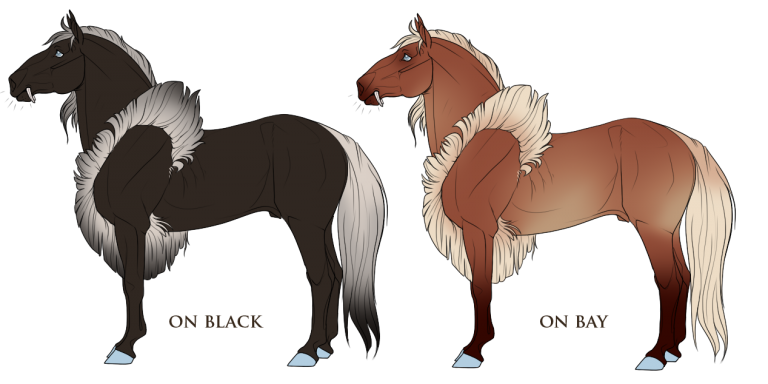
SILVER – nZ / ZZ
- Unlike flaxen, the silver gene dilution only expresses on black or bay bases. It acts by diluting the mane to a blond/silvery/white color; black horses may dilute to a chocolate color, have silver intermingled with their coat, or remain a normal black shade, and bays may dilute to a dull, reddish color with chocolate-like points, or remain a normal shade. When other dilutions, such as cream are added, the coat can be diluted in the same ways mentioned above. Dapples, which can be silvery, are usually present as well.
Silver Black (normal shade) | Silver Black (diluted shade)
Silver Bay (normal shade) | Silver Bay (diluted shade)
GREY – nG / GG
- Grey is a dominant gene that causes the horse’s natural coat color to slowly “depigment” as the horse ages regardless of the color. Most greys go through a dappled phase, ending up nearly white or sometimes fleabitten. Grey horses will often show patches of ungreyed coat that remain colored, called ‘bloody shoulders’ or ‘bloodmarks’ – they may appear on Greys who do not have Somatic Mutations, but Bloody Shoulders will not cover more than 25% of the body.
Grey horses are genetically susceptible to forming melanomas, which are a type of skin cancer. 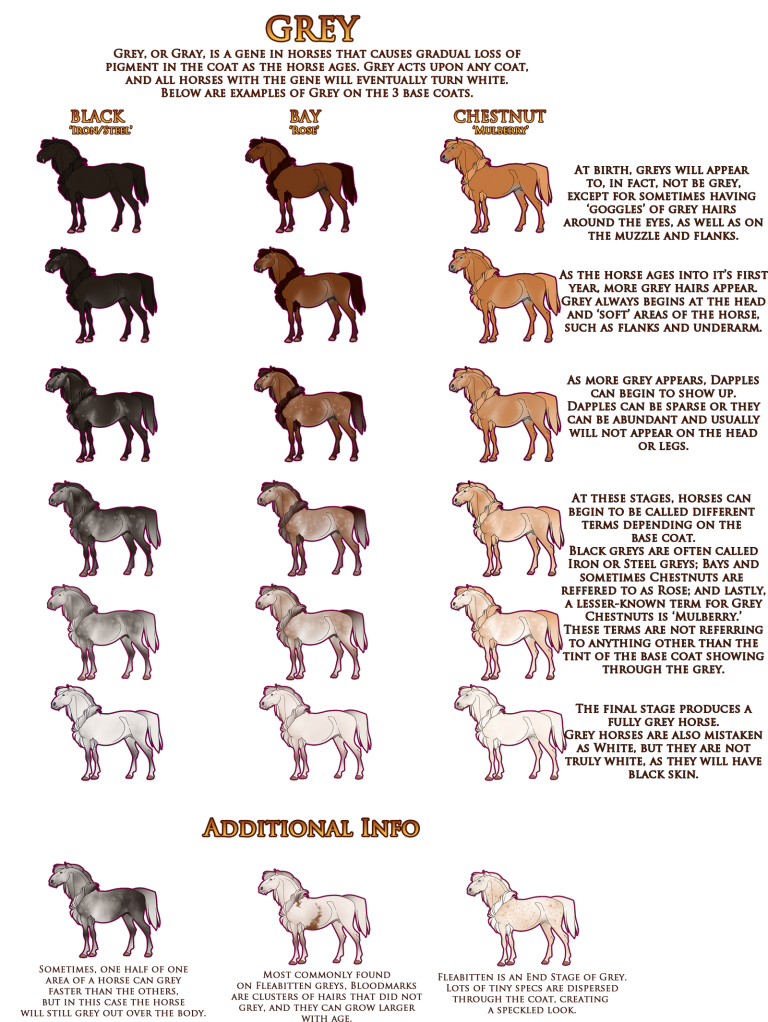
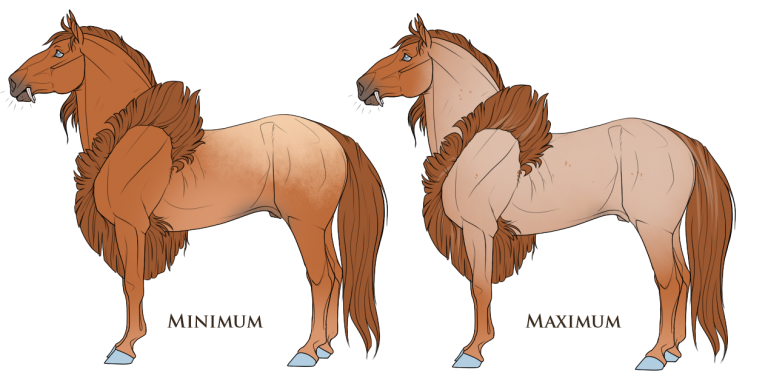
ROAN – nR / RR
Roan is caused by the KIT gene, which causes white markings in horses such as Tobiano. However, to make things easier as we do not lump Roan with White markings, so we have put Roan with dilutions & modifiers.
- The roan gene acts by dispersing white hairs throughout a horse’s coat. The head, legs, mane, and tail remain dark, creating ‘inverted V’s’ on the legs when they are covered. Roan can act on any of the base colors as well as on any dilute or patterned color. Basic shades of roan include red or strawberry roan (chestnut), bay roan and blue roan (black). When a roan horse becomes injured, such as sustaining a cut or bite, the hair will grow back the base coat color. ‘Corn Spots‘ can also appear on a roan horse, which is small dots of the base coat color within the roan. Buckskin and similarly-colored horses have the ability to have a sort of grey-toned roan.
White Markings
‘Paint’ Markings
White Markings on horses come in many shapes, can occur on any coat, and can even combine with each other. Below, we will go into a comprehensive study of white markings! In Ballators, we recognize the following white markings:
- Minimal White
- Tobiano
- Splash
- Overo (Frame)
- Sabino
- Rabicano
- Dominant White
In Ballators, we take a looser stance on white markings than those seen in real life and have tried to simplify them to be easier to understand.
NOTE: The below sections are image-heavy and any clicked image will take you to DeviantArt; any clicked link will keep you on-site.
- Minimal White markings are any white marking that can appear on a horse’s face and/or legs without the presence of a gene that causes White – though it can appear on horses with a White Marking gene. Markings may be irregular, such as a face marking that tends towards one side of the face or a leg marking that only covers half the hoof area, or they can combine, for example a horse with both a snip and star and a horse with both a sock and a heel mark on opposing legs.
Includes the following basic Facial Markings:
Star | Snip | Stripe | Blaze
These markings can vary greatly in size, placement, shape, combination, symmetry, etc! However, facial markings will not be large/Covering a wide area of the face, cross the face diagonally, touch the jaw behind the chin, touch the ears, or touch/color the mane. These markings also will not cover the eyes or create a Bald face as that is attributed to Splash and Overo. These markings will be solid, without bountiful internal spots or holes unless a mutation such as Belton Spots is present. However, facial markings may be interrupted, which means a ‘chunk’ has been removed. It will be a solid chunk of the marking, as if a part was simply erased, like so: Interrupted Blaze | Interrupted Blaze/Star | Interrupted Star - Includes the following basic Leg Markings:
Coronet | Pastern | Sock | Stocking
These markings can vary greatly in size, placement, shape, combination, symmetry, etc! However, leg markings will not cross the top of the knees. Leg markings may also express Ermine Marks, which are small, circular holes in the white leg markings that only occur around the coronet. -
Markings that are Not Minimal White
Large White Facial Marks or Over-Knee Stockings | Caused by a white marking like Splash. Minimal White generally will not pass the chin or spread over the bridge of the nose. Minimal White leg markings will not cross over top of the knee.
Badger Face | Caused by a large ‘spot’ being ‘cut out’ of a Bald facial marking, Badger Faces only occur on horses with the splash and overo genes.
Bald Face | Caused by the splash and overo genes only.
Interrupted Blaze: galloptodiscover.com | Interrupted blaze/star: pinterest.com | Interrupted Star: dreamstime.com
- Tobiano is characterized by white crossing the horse’s back between the withers and the dock, coming from the spine down, as well as by areas of color on the head, chest, and flanks. Most tobianos have normal face markings like stars and blazes, and they always have four white feet. The most minimally marked tobianos appear to have only 4 stockings. Tobiano will affect mane color, turning affected manes white. Some might show clusters of ‘holes’ around the edges of the white markings, called cat tracks. Tobiano markings tend to have smooth, crisp edges.
Minimally, tobiano must cover all four feet at the coronet.
Maximally, tobiano can cover the whole body except the entire head – the head may have a facial marking, such as a blaze, however. - Ballator Examples:
Minimal Tobiano | Medium Tobiano | Maximal Tobiano - From-Life Examples:
Minimal Tobiano | Medium Tobiano | Maximal Tobiano
Min. Tobiano: Colorgenetics.info | Med. Tobiano: Horse-genetics.com | Max. Tobiano: EquineTapestry.com
- Splash horses look as if they’ve literally been splashed with white paint from the underside or dipped in white paint. Splash will not touch the spine unless the horse is maximum or near-maximum splash; Splash markings tend to have smooth, crisp edges. Splash is one of the few markings that can be present in the genotype but hidden on the horse, meaning that the horse does not express it. Splash may create badger-faced markings, which is a ‘hole’ cut out of a larger facial marking. Badger face 1 | Badger face 2 . If splash covers the ears, the horse may be deaf.
Minimally, splash can be hidden, or it can appear as a small belly spot or leg marking.
Maximally, splash can cover the whole horse. - Ballator Examples:
Minimal Splash | Medium Splash | Maximal Splash - From-Life Examples:
Minimal Splash | Medium Splash | Maximum Splash
Min. Splash: EquineTapestry.com | Med. Splash: EquineTapestry.com | Max. Splash: EquineTapestry.com
- Overo horses, also called Frame or Frame Overo, are characterized by having a dark topline between the withers and dock, with blocks of white on their sides and necks. Frame overos usually have large blazes or facial markings. The feet and legs are usually dark, but may be white as well. Edges of overo markings are crisp and can be jagged. If a horse is homozygous for frame (OO) it will die shortly after birth due to a defect called Lethal White Overo (LWO). There is no cure for LWO as it causes the foal’s intestines to be malformed. Overo is one of the few markings that can be present in the genotype but hidden on the horse, meaning that the horse does not express it.
Minimally, overo can be hidden, or it can appear as a small belly or body spot, or a facial marking.
Maximally, splash can cover the whole horse except the back. - Ballator Examples:
Minimal Overo | Medium Overo | Maximal Overo - From-Life Examples:
Minimal Overo | Medium Overo | Maximal Overo
Min. Overo: horse-genetics.com | Med. Overo: EquineTapestry.com | Max. Overo: cactusroseranch.com
- Sabino is a pattern that comes in many forms. In its minimal form, it only manifests itself as small socks and a star or blaze that have ticked or frosty edges. More extreme sabinos will have white patches, with roaned/ticked/frosty edges, going up their sides from the underside of the belly; Sabino often will color the underside of the jaw white. The most extreme sabinos will look entirely white or nearly so, often retaining a few patches of color along their toplines, particularly on the ears or in the mane.
Sabino may cause a white/silver tail, often with a good amount of dark hairs mixed in, called Gulastra plume. If showing a plume, a horse will either have only small sabino markings or no other sabino markings.Minimally, sabino can manifest only as a white/silver tail with many dark hairs intermingled.
Maximally, sabino can cover most of the horse except a few areas like the ears, neck, or back. - Ballator Examples:
Minimal Sabino | Medium Sabino | Maximal Sabino - From-Life Examples:
Minimal Sabino | Medium Sabino | Maximal Sabino
Min. Sabino: fingerlakesfinesttbs.com | Med. Sabino: homecomingbook.wordpress.com | Max. Sabino: aqha.de
- Rabicano is usually manifested as a sprinkling of white hairs radiating out from a horse’s flank in a stripe-like fashion, sometimes spreading across the barrel and onto the shoulder. Rabicano often creates a roan-like appearance on the barrel and flank. Rabicanos also have a white-topped tail, known as a coon tail or skunk tail.
Minimally, rabicano can manifest as small roany patches with classic rabicano ‘stripes’ on the belly.
Maximally, rabicano can cover most of the horse’s belly, flank, and part of the shoulder. - Ballator Examples:
Minimal Rabicano | Medium Rabicano | Maximal Rabicano - From-Life Examples:
Minimal Rabicano | Medium Rabicano | Maximal Rabicano
Min. Rabicano: Wikipedia.com | Med. Rabicano/Skunk Tail: Wikipedia.com | Max. Sabino: wikipedia.com
- Most dominant white horses tend to be heavily patterned or nearly all white, even though the amount of white on the coat can vary. Dominant White is a broad term that covers over 20 different white patterns, so the number of ways it can look is nearly uncountable. Like frame overo, dominant white is lethal in its homozygous state (WW). Dominant White, when it does not cover the whole horse, will not have flat edges like Splash; edges of the marking will be roany, ticked, speckled, or very erratic and jagged.
Minimally, dominant white can manifest as most of the horse being covered with white.
Maximally, dominant white will cover the entire horse. - Ballator Examples:
Minimal Dominant White | Medium Dominant White | Maximal Dominant White - From-Life Examples:
Minimal Dominant White | Medium Dominant White | Maximal Dominant White
Min. Dom. White: Equinetapestry.com | Med. Dom. White: Facebook.com | Max. Dom. White: Pinterest.com
Appaloosa Markings / The Leopard Complex
Appaloosa Markings, otherwise known as the Leopard Complex, on horses come in many shapes, can occur on any coat, and can even combine with each other. Below, we will go into a comprehensive study of Appalosoa markings! In Ballators, we recognize the following appaloosa markings:
- Varnish Roan
- Frosted
- Snowflake
- Spotted Blanket
- Leopard
- Snowcap
- Fewspot
- Semi-Leopard
In Ballators, we take a looser stance on appaloosa markings than those seen in real life and have tried to simplify them to be easier to understand.
ANOMALIES / ADDITIONAL APPALOOSA TRAITS
COLOR SHIFTING / BRONZING – No Gene / ONLY Occurs on Black Based Coats.
Color shifting, also known as Bronzing, is an interesting anomaly that occurs on black-based appaloosa horses. This bronzing causes the coat to turn a dull, red or bronze color, hence the name. Bronzed appaloosas could easily be mistaken for a red-based horse.
Bronzing can cause a very dull pewter coat color, a bronze-y coat color, and pewter-toned lower legs. Manes and tails will be close in color to the base coat. Horses must be expressing Appaloosa to be bronzed. They will not appear too red or chestnut colored; they must be dull, almost red-dun in shade.
If you make your black-based appaloosa horse color shifted or bronzed, you must put ‘Color shifted’ or ‘Bronzed’ in front of the phenotype.
-
- Ballator Examples:
Bronzed, warm base | Bronzed, darker base | Bronzed, pewter-like base - From-Life Examples:
Ava Minted Design, a color-shifted Grullo
Sprinkles, a color-shifted black
Example of pewter-colored lower legs
- Ballator Examples:
Ava Minted Design: Designsporthorse.com | Sprinkles: Equinetapestry.com
MISMARKS – No Gene
Mismarks are the result of the appaloosa gene accidentally ‘messing up’ a section of appaloosa marking, causing what appears to be a large hole in the marking. Mismarking can occur on any Appaloosa mark except Snowflake.
Minimally, mismarks can be fairly small and occur as what appears to be a cluster of holes.
Maximally, mismarks may only cover 50% or less of the body.- Ballator Examples:
Mismarked Fewspot | Mismarked Leopard | Mismarked Blanket | Mismarked Semi-Leopard - From-Life Examples:
Minimal Mismark | Medium Mismark | Maximal Mismark
Min. Mismark: Pinterest.com | Med. Mismark: Pinterest.com | Max. Mismark: Pinterest.com
MOTTLED SKIN / MOTTLING – No Gene
Mottling is very common in appaloosa horses; it is simply small spots on the skin around the eyes and muzzle, giving the skin a mottled appearance. It should not be mistaken for Vitiligo, which causes white spots on the skin and coat. Mottling only appears on the skin around the eyes or muzzle, not all over the coat. It can make the hair around the eyes a greyish or lighter white color. You do not / should not mark mottling in the phenotype, as it is simply ‘freckles’!
Minimally, mottling can appear on just the muzzle.
Maximally, mottling can appear on the muzzle, around the eyes, and where skin is visible such as the genitals and belly area.- Ballator Examples:
Minimal Mottling| Medium Mottling | Maximal Mottling - From-Life Examples:
Minimal Mottling | Medium Mottling | Maximal Mottling
Min. Mottles: icaainc.com | Med. Mottles: Equinetapestry.com | Max. Mottles: deviantart.com
LP ONLY
The below list contains only nLp variations, with no Patn (pattern) gene. These are the ‘simplest’ versions of Appaloosa; they will not have any spotting except for ‘holes’ in Varnish and Frosted varieties; only Varnish will affect mane color, and only minimally.
VARNISH ROAN – nLp(roan)
Varnish roan is similar to true roan, but more scattered and uneven; the bony or hard parts of the horse, such as the nose, cheek bones, legs, hip, etc, will not have roaning on them. The more dense white areas start over on the hindquarters and can extend over to the face; soft or fleshy areas of the horse will have the most white. Varnish Roan can have holes in the roan on the rump area that are reminiscent of Blanket Appaloosa spots. It won’t affect mane color in a great way, rather it may cause a few grey-white streaks.
Minimally, Varnish Roan can simply appear as a dusting of white across the topline, hips, or shoulder and face.
Maximally, Varnish Roan will cover the whole horse except the bony areas.- Ballator Examples:
Minimal Varnish Roan | Medium Varnish Roan | Maximal Varnish Roan - From-Life Examples:
Minimal Varnish Roan | Medium Varnish Roan | Maximal Varnish Roan
Min. Varnish: Equinetapestry.com | Med. Varnish: Pinterest.com | Max. Varnish: Equinetapestry.com
FROSTED – nLp(frost)
Frosted appaloosa markings will range from a roaned, uneven blanket to markings similar to varnish roan; it can make the horse look as though it has been lightly snowed on or caught in an onset of winter frost, hence the name. It starts from the horse’s hindquarters and extend from there to the shoulder, but can cover the hips, barrel, and neck. Frosted may appear as a very roaned/frosty solid blanket with no spots, or it can appear similar to roan, where the base coat is slightly visible beneath it. Frosted horses may have some very small/scattered amounts of holes in the design, such as this horse, but not to the extent of spotting over the whole body.
Minimally, Frosted can cover a small dusting over the topline.
Maximally, Frosted can cover the topline, barrel, hips, shoulder, and some of the neck.- Ballator Examples:
Minimal Frosted | Medium Frosted | Maximal Frosted - From-Life Examples:
Minimal Frosted | Medium Frosted | Maximal Frosted
Min. Frosted: Equinetapestry.com | Med. Frosted: Pinterest.com | Max. Frosted: Pinterest.com
SNOWFLAKE– nLp(snow)
Snowflake causes random flecks of white spotting, smaller than or no larger than a dime, across the horse’s body. The coat can be heavily or minimally affected, with concentrated spots or widely dispersed ones. Snowflake will not affect mane color. Snowflake should not be confused with horses who have suffered fungal infections, such as this horse and this horse.
Minimally, Snowflake can only appear as a few spots across the body.
Maximally, Snowflake can cover the whole horse in small white spots; some spots may cluster, but not over a large area.- Ballator Examples:
Minimal Snowflake| Medium Snowflake | Maximal Snowflake - From-Life Examples:
Minimal Snowflake| Medium Snowflake | Maximal Snowflake
Fungal Infections: EquineTapestry.com | Min. Snow: Wikipedia.com | Med. Snow: Theappaloosacom | Max. Snow: Pinterest.com
LP + PATN1
The below list contains only Lp + the Patn1 (Pattern 1) gene, which controls high-coverage appaloosa markings over the whole body.
Horses with only Patn1 (no semi-leopards) will not have darker spots on their Appaloosa markings and the appaloosa markings will always affect mane color.
LEOPARD – nLp(Patn1)
Leopard horses are covered with white, which has ‘holes’ or spots of varying sizes that shows the base coat beneath. These holes/spots can be clustered in some areas, but will never form patches of color unless mismarked. Mane and tail will be white where the spots don’t touch, and colored tips on the hair may appear.
Minimally, leopard must cover the whole body (unless mismarked), with only a handful of holes in the white.
Maximally, leopard must cover the whole body (unless mismarked), with large, very dispersed spots.- Ballator Examples:
Minimal Leopard | Medium Leopard | Maximal Leopard - From-Life Examples:
Minimal Leopard Spots | Medium Leopard Spots | Maximal Leopard Spots
Min. Leopard: Pinterest.com | Med. Leopard: Pinterest.com | Max. Leopard: Equinetapestry.com
FEWSPOT– LpLp(Patn1)
Fewspot appaloosas are characterized by, as the name suggests, only a few spots compared to Leopard. They’re completely covered in white, with just a few colored spots showing, most notably around the face, elbows, flank, and legs. These spots might be scattered or show in small clusters around soft zones. Mane and tail will show white where touched by white, but tips of the hair might be colored.
Minimally, Fewspot will appear to cover the whole body with only a very small amount of spots.
Maximally, Fewspot will have large ‘holes’ or clusters around soft spots and/or legs.- Ballator Examples:
Minimal Fewspot | Medium Fewspot | Maximal Fewspot - From-Life Examples:
Minimal Fewspot | Medium Fewspot | Maximal Fewspot
LP + PATN2
The below list contains only Lp + the Patn1 (Pattern 1) gene, which controls high-coverage appaloosa markings over the whole body.
Horses with only Patn2 (no semi-leopards) will have darker spots on their Appaloosa markings if they are nLp (not LpLp) and the appaloosa markings will not affect mane color.
SPOTTED BLANKET – nLp(Patn2)
Spotted Blanket will usually consist of a white blotch on the horses’ hindquarters which has a number of differently sized and shaped darker spots within and around it. Blankets may extend up to the withers, and sometimes have darker spots scattered around the shoulder and barrel area. The edges of the blanket might appear a bit roaned, ticked, or flecked, but not as much as frosted markings. Will not affect mane color.
Minimally, blanket appaloosa can be hidden, or not expressed. If expressing, a small white patch on the rump must be visible with some darker spots.
Maximally, blanket appaloosa can extend up to the withers and down to the stifle.- Ballator Examples:
Minimal Blanket | Medium Blanket | Maximal Blanket - From-Life Examples:
Minimal Blanket | Medium Blanket | Maximal Blanket
Min. Blanket: GoodHorse.com | Med. Blanket: Pinterest.com | Max. Blanket: Pinterest.com
FEWSPOT– LpLp(Patn2)
Snowcaps are visually and placement-wise identical to blankets. However, snowcaps will consist of a solid patch of white with no spots. It may have a few small pinprick holes around the edges, but it will contain no dark spots or holes like a Blanket.
Minimally, snowcap will appear as a small patch of white on the rump.
Maximally, snowcap can extend up to the withers and down to the stifle.- Ballator Examples:
Minimal Snowcap | Medium Snowcap | Maximal Snowcap - From-Life Examples:
Minimal Snowcap | Medium Snowcap | Maximal Snowcap
SEMI-LEOPARD – LpLp(…)
At the most basic level, Semi-Leopard can be categorized as two Appaloosa patterns being present on one horse. It varies greatly in presentation and coverage; below you will see examples of all possible Semi-Leopard Combinations.
Roan refers to Varnish Roan.
Frost refers to Frosted.
Snow refers to Snowflake.
Patn1 is the Leopard-causing pattern; you will never get a Fewspot semi-leopard since Fewspot requires two copies of Lp and one copy of Patn1 only.
Patn1 is the Blanket-causing pattern; you will never get a Snowcap semi-leopard since Snowcap requires two copies of Lp and one copy of Patn2 only.
NOTE that the following guide may contain images of horses who are not, for example, Snow/Roans, but appear as a Snow/Roan. These are just visual examples to help you design!

VARNISH ROAN + FROSTED
Varnish Roan + Frosted or Frosted + Varnish Roan will appear as a Varnish horse with a frosted marking. This is a very simple pattern of Semi-Leopard and straightforward to design!
Minimally, this semi-leopard expression must contain elements of minimal varnish roaning AND minimal frosted.
Maximally, this semi-leopard expression may contain maximal varnish roaning AND maximal frosted.- Ballator Examples:
ID 5513 - From-Life Examples:
Frost/Roan, minimal roaning
Min. Roaning: Pinterest.com

VARNISH ROAN + SNOWFLAKE
Varnish Roan + Snowflake or Snowflake + Varnish Roan will appear as a Varnish horse with Snowflakes across the body. This is a very simple pattern of Semi-Leopard and straightforward to design!
Minimally, this semi-leopard expression must contain elements of minimal varnish roaning AND minimal Snowflaking.
Maximally, this semi-leopard expression may contain maximal varnish roaning AND maximal snowflake.- Ballator Examples:
ID 8165 | ID 7844 (plus archetain interaction) - From-Life Examples:
Roan/Snow, minimal snowflake | Roan/Snow, Max. snowflake
Min. Snowflake: Pinterest.com | Max. Snowflake, Med. Varnish: seeingspotsfarm.com
FROSTED + SNOWFLAKE
Frosted + Snowflake or Snowflake + Frosted will appear as a frosted appaloosa with Snowflakes across the body. This is a very simple pattern of Semi-Leopard and straightforward to design!
Minimally, this semi-leopard expression must contain elements of minimal frosting AND minimal snowflaking.
Maximally, this semi-leopard expression may contain maximal frosting AND maximal snowflake.- Ballator Examples:
ID 7258 | ID 8573 - From-Life Examples:
Frost/Snow, medium snowflake, max frost | Frost/Snow, Medium
Med/Max: horsegenetics.com | Med/med: pearls-and-polo-wraps.com

PATN2 + SNOWFLAKE
Patn2 + Snowflake will appear as a Blanket appaloosa with Snowflakes across the body. Snowflakes may express normally or can congregate around the blanket. Semi-Leopard can make the patn2 gene amplify; blanket does not have to follow the normal boundaries of how far it can reach, but it cannot, for example, create a ‘blanket’ on the neck or head. It still must originate from the rump.
Minimally, this semi-leopard expression must contain elements of Blanket AND minimal snowflaking.
Maximally, this semi-leopard expression may contain maximal Blanket, even slightly more maximal than normal, extending the blanket to the shoulder, AND maximal snowflake.- Ballator Examples:
ID 6079 | ID 8758, showing extended blanket - From-Life Examples:
Patn2/Snow, minimum snowflake | Patn2/Snow, Max Snow
Min Snow: thepaws.com | Med/max: horsebreeds.com

PATN2 + FROSTED
Patn2 + Frosted will appear as a Blanket appaloosa with frosting, either around the blanket/body or incorporated into the blanket itself. Semi-Leopard can make the patn2 gene amplify; blanket does not have to follow the normal boundaries of how far it can reach, but it cannot, for example, create a ‘blanket’ on the neck or head. It still must originate from the rump.
Minimally, this semi-leopard expression must contain elements of Blanket AND minimal frosting.
Maximally, this semi-leopard expression may contain maximal Blanket, even slightly more maximal than normal, extending the blanket to the shoulder, AND maximal frosting.- Ballator Examples:
ID 5045 | ID 6383 | ID 7516 - From-Life Examples:
Patn2/Frost , minimum blanket | Patn2/Frost, Max Snow
Min Blanket: Pinterest.com |

PATN2 + VARNISH
Patn2 + Varnish will appear as a Blanket appaloosa with varnish roaning beneath the blanket. Semi-Leopard can make the patn2 gene amplify; blanket does not have to follow the normal boundaries of how far it can reach, but it cannot, for example, create a ‘blanket’ on the neck or head. It still must originate from the rump.
Minimally, this semi-leopard expression must contain elements of Blanket AND minimal Varnish.
Maximally, this semi-leopard expression may contain maximal Blanket, even slightly more maximal than normal, extending the blanket to the shoulder, AND maximal Varnish.- Ballator Examples:
ID 678 | ID 3405 - From-Life Examples:
Patn2/Roan, minimum blanket | Patn2/Roan, Max Roan, med blanket
Min Blanket Max Roan: Pinterest.com | Max Roan/Med Blanket: Pinterest.com |

PATN1 + SNOWFLAKE
Patn1 + Snowflake will appear as a Leopard appaloosa with Snowflakes across the body. Snowflakes may express normally or can congregate around the leopard marking. Semi-Leopard can make the Leopard marking look cut off at around the legs or head.

PATN1 + FROSTED
Patn1 + Frosted will appear as a Leopard appaloosa with frosting, either around the body or incorporated into the leopard itself. Semi-Leopard can make the Leopard marking look cut off at around the legs or head.
- Minimally, this semi-leopard expression must contain elements of Leopard AND minimal frosting.
Maximally, this semi-leopard expression may contain maximal Leopard AND maximal frosting. - Ballator Examples:
ID 5743 - From-Life Examples:
Frosty-Edged Semi-Leopard
- Minimally, this semi-leopard expression must contain elements of Leopard AND minimal frosting.
Frosty Edged: ShoestringStable.com |

PATN1 + VARNISH
Patn1 + Varnish will appear as a Leopard appaloosa with varnish roaning beneath the leopard marking. Semi-Leopard can make the Leopard marking look cut off at around the legs or head.
- Minimally, this semi-leopard expression must contain elements of Leopard AND minimal Varnish.
Maximally, this semi-leopard expression may contain maximal LeopardAND maximal Varnish. - Ballator Examples:
ID 6401 | ID 5367 - From-Life Examples:
Patn1/Roan, Maximum Roan | Patn1/Roan, Min roan
- Minimally, this semi-leopard expression must contain elements of Leopard AND minimal Varnish.
Max Roan: Pinterest.com | Min Roan: Pinterest.com |

PATN1 + PATN2
Patn1 + Patn2 is the most extensive and versatile of the Semi-Leopard patterns. It combines the wide range of Leopard with the intricate spotting and pattern of the Blanket into a unique design.
- Minimally, this semi-leopard expression must contain white appaloosa markings with spots and holes. PATN2 darker spots should be visible.
Maximally, this semi-leopard expression may cover most of the body in a unique spotted design. - Ballator Examples:
ID 6642 | ID 6636 | ID 8227 | ID 5675 | ID 6374 - From-Life Examples:
Patn1/Patn2: Minimal Patn2 Spots | Medium Patn 2 Spots | Heavy Spotting
- Minimally, this semi-leopard expression must contain white appaloosa markings with spots and holes. PATN2 darker spots should be visible.
Min Patn2 Spot: Pinterest.com | Med. Patn2 Spots: Pinterest.com | Heavy Spotting: Chickensmoothie
Free-To-Add Elements
The below list is a compilation of several design elements that you are allowed to add to any design. You do not need to add these into your phenotype unless specified!
Genes that can be Hidden refers to a horse that has a gene in it’s genotype, but it does not express on the horse. This is similar to a carried gene, but hidden genes are not carried; they are simply not present on the horse rather than having an additional reason for them being carried.
You must mark a hidden gene in the phenotype as “(hidden)” in the phenotype, like so:
Black splash (hidden) with hornstripe
Hide-able genes:
♦ Splash
♦ Blanket Appaloosa
♦ Semi-Leopard Appaloosa
♦ Dominant White (Note that there are many variations of dominant white)
♦ Overo
Natural genes that must always show when present in the genotype unless it is carried:
Leopard Appaloosa
Fewspot Appaloosa
Frosted Appaloosa
Snowcap Appaloosa
Varnish Roan Appaloosa
Tobiano
Rabicano (Even if just by Skunk Tail)
Sabino (Even if just by Gulastra Plume)
Silver
Dun
Flaxen
Roan
Grey
Champagne
Pearl (prlprl) / Cream Pearl
Cream
+ All other natural genes
All Ballator mutations, unless hidden by another gene or carried, must show on the horse.
Lacing, or Reverse Dappling, is often found on grey horses but can also be seen on other horses without the Grey gene. On Greys, it causes soft-edged reverse dapples, as if an outline of the dapples had been made with a soft brush. On non-greys, lacing is a sharp white marking that comes from the spine down and does not pass the halfway point of the barrel of the horse.
Writing in the Phenotype: Black splash with lacing
- Minimally, lacing can be small white lines on the spine.
Maximally, lacing will cover most of the spine and extend minimally down the body on a non-grey. On a grey, lacing can cover a large portion of the body. - Ballator Examples:
ID 8534
ID 8452
ID 8714 - From-Life Examples:
Lacing on a Grey | Maximal lacing on a Grey
Minimal Lacing on non-grey | Medium/Near-Maximum Lacing on non-grey
- Minimally, lacing can be small white lines on the spine.
Lacing on Grey: equinetapestry.com | Max. Grey Lacing: pinterest.com | Minimal Lacing: equinetapestry.com | Maximal Lacing: pinterest.com
Blood marks are identified as an area where the grey gene does not affect a certain part of the coat. It can be dense collections of flea bites on flea-bitten greys, or a fuzzy-outlined area of non-grey for example. While Somatic Mutations can cause this same affect, Blood marks are not allowed to cover the extent of the area of a Somatic mutation; blood marks can only affect up to 25% of the horse. Blood marks will only appear on fully-grey or near-fully grey horses.
Writing in the Phenotype: (No changes needed) Greying black splash
- Minimally, blood marks can appear anywhere on the body and can be very small.
Maximally, blood marks can cover anywhere on the body, but only 25% of the whole horse. - Ballator Examples:
ID 7919
ID 6865
ID 5700 - From-Life Examples:
Feint blood mark | Dense, small blood mark
Small flea-bite bloodmark | Large bloodmark
- Minimally, blood marks can appear anywhere on the body and can be very small.
Feint blood marks: Breyerhorses.com | Dense small: Horsenetwork.com | Small flea bites: Breyerhorses.com | Large: tumblr.com
Cat Tracks most often occur in homozygous (TT) tobianos, but can occur on heterozygous (nT) as well. They appear as holes in the spots that are medium to small sized and often have a fuzzy or erratic edge, as if a cat walked across them, hence the name.
Writing in the Phenotype: (No Changes needed) Black tobiano
- Minimally, cat tracks can be small and affect only part of the tobiano.
Maximally, cat tracks can be medium-sized (about the size of a hoof or a little larger) and cover the whole tobiano area. - Ballator Examples:
ID 5143
ID 6688
ID 7477 - From-Life Examples:
Close-up of cat tracks | Minimal Cat tracks | Medium cat tracks | Maximum cat tracks
- Minimally, cat tracks can be small and affect only part of the tobiano.
Close-up: equinetapestry.com | Minimal: pinterest.com | Medium: pinterest.com | Maximum: pinterest.com
Vitiligo is a skin condition that presents itself as circular spots on the horse that lack pigment; hair on these spots will be white, while the skin will be pink. It can occur anywhere on the body and present as small, clustered patches or larger patches that can cover 25% of the horse at maximum. It most often occurs around the muzzle, lips, eyes, and genitals.
Writing in the Phenotype: Black tobiano with vitiligo
- Minimally, vitiligo can occur as small circular spots on the body.
Maximally, vitiligo can form chains or large clusters across 25% of the body. - Ballator Examples:
ID 6230
ID 6902
ID 5503 - From-Life Examples:
Vitiligo on the Face | Minimal Vitiligo on the Muzzle
- Minimally, vitiligo can occur as small circular spots on the body.
Facial: vetstream.com | Minimal: ScienceDirect.com
Randomly Rolled Mutations
Every so often, you may get lucky in a breeding and receive a randomly rolled mutation. These can only be added to your horse if they appear in the breeding note or if you use an item to pass or guarantee a RRM.

Required Traits:
– Creamy or white body color with pink skin
– True albinos must have a true horn color designed for them.
– Pseduo albinos may only express the mutations listed in the guide, and they all with have a creamy color as well.
– Pseudo albinos must have their normal horn color showing.
Note that this albino guide does not apply to Poecilias, as a True Albino Poecilia does not need the nX gene, rather an albino Poecilia is a mutation within the Poe gene itself.
BELTON SPOTS
Belton spots are spots occurring in a horse’s white markings, usually facial or on the legs, that appear as though parts of them were erased. They can be large or small, and appear on non-paint markings or on paint markings and are most abundant around the face and feet. They can appear on the body, but never as abundant as on the face or feet, and Body Spots will be much smaller.
- Ballator Examples:
Minimal Belton | Medium Belton | Maximal Belton - From-Life Examples:
Belton on the Feet | Minimal Belton | Maximal Belton
- Ballator Examples:
Belton on Feet: Equine Tapestry | Min. Belton: Equine Tapestry | Max. Belton: Pinterest.com
BEND-OR SPOTS
Bend-Or Spots are random, dark spots on a coat; they are darker than the base coat. They can vary greatly in size, even though they are no bigger than an outspread hand. They are also known as ‘Grease Spots.’
- Ballator Examples:
Minimal Bend-Or | Medium Bend-Or | Maximal Bend-Or - From-Life Examples:
Collected Bend-Or | Minimal Bend-Or | Maximal Bend-Or
- Ballator Examples:
Collected: Pinterest | Min. Bend Or: Pinterest | Max. Bend-Or: Pinterest.com
BIRDCATCHER SPOTS
Birdcatchers or are small, round, white spots scattered throughout a horse’s coat. They may look lightly clustered or few and spread out; they look very close in appearance to snowflake appaloosa.
- Ballator Examples:
Minimal Birdcatcher | Medium Birdcatcher | Maximal Birdcatcher - From-Life Examples:
Minimal Birdcatcher | Medium Birdcatcher | Maximal Birdcatcher
- Ballator Examples:
Min. Birdcatchers: EquineTapestry | Med. Birdcatcher: ColorGenetics.com | Max. Birdcatcher: HorseForum.com
PATCHED CHIMERA & BRINDLE CHIMERA
Chimeric horses are the result of two embryos fusing into a single embryo in the womb. It is exceedingly rare in real horses with only 3-4 documented cases. Patched Chimera represents both coats of the individual embryos present on the horse as patches of different colors. The two coats are determined by the parent’s genes, and either one has a possibility to pass on to offspring. Brindled chimera is the same concept as Patched, but Brindled Chimera is a pattern that shows in the form brindle bars on the horse. These can be limited from a few bars to a completely covered horse.
Reading your Chimera Genotype: The first base color – for example, in a chestnut/black chimera – will be the horse’s main base color. If a horse is Patched chimera, the horse can have any amount of Black patches. If it is a brindle chimera, the horse in our example would be chestnut with black brindle.
The below links to Ballator Examples will take you to Deviantart.
-
- Ballator Examples:
Patched Chimera (Red Dun/Black) | Patched Chimera (Wild Bay / Bay) | Brindle Chimera (Red Dun/ Albino) | Brindle Chimera (Perlino / Buckskin) - From-Life Examples:
Litningur frá Möðrufelli – Confirmed Chimera
- Ballator Examples:
Litningur: Pinterest.com | Med. Birdcatcher: ColorGenetics.com | Max. Birdcatcher: HorseForum.com
CRYPTIC MERLE – nM
Cryptic merles are rolled from Merle breedings; these merles show only very slight merle coloration, and in some cases it is not visible at all. The horse may have only small patches of merle, for example, at the rump or ear or the merle coloration can be concealed completely by white markings. Like all merles, Cryptic Merles have the chance of inheriting a Merle Effect defect.
HETEROCHROMIA
Heterochromia affects the eyes of the horse. There are three types of Heterochromia: Complete, partial, and central. In Ballators, there is also a fourth type, which is called, simply, Ballatorian Heterochromia. Complete heterochromia is where the iris of one eye is a completely different color than the iris of the other eye. Partial Heterochromia is where only a part of the iris of one eye has a different color than the rest of the iris of that eye. Partial heterochromia can occur in one eye or both eyes. In Central Heterochromia, the iris has a different color near the border of the pupil, with spikes of the central color radiating from the pupil toward the middle of the iris. In Ballatorian Heterochromia, the gene that normally causes the eye color to be the same color as the horns is turned off, and is able to turn the eyes any color, but these cannot show any more than one color. For example, a blue-horned horse can show two solid red eyes only. It cannot show red eyes with gold streaks, for example.
If you roll heterochromia, you may choose between any of the types. The secondary color can be any color you desire.
- Ballator Examples:
Complete Heterochromia | Partial Heterochromia | Central Heterochromia | Ballatorian Heterochromia
- Ballator Examples:
Image Credits:
Complete Heterochromia: Pinterest.com | Partial Heterochromia: azretina.com | Central Heterochromia: actforlibraries.org
SOMATIC MUTATION
Somatic mutations are the result of a gene that is switched “off,” resulting in odd patches of color on an otherwise ordinary coat. A Palomino horse can have a Somatic Mutation wherein the Cream gene is turned off in one area of the coat, resulting in a Chestnut-Colored patch, or a mutation may occur that turns that section of coat completely white due to lack of melanin; in the case of the marking being white, the markings will almost always be stripe-like or linear. Somatic will be irregular in shape, with no more than 50% of the body/coat being affected at one time. Somatic will not turn off Ballator mutations, with the exception of the Somatic being white, which will cover ALL markings, and any Base coat-related gene (Taffy, Sunset, or Chrome).
-
- Ballator Examples:
ID 7394: White ‘Patch’ Somatic | ID 8923: ‘Frosty’ White Somatic | ID 8190: Striped White Somatic
Somatic Deactivating Roan | Somatic Turning off ‘Aa’, showing Black Coat | Somatic turning off ‘EE’, showing a Dark Chestnut Coat - From-Life Examples:
Somatic turning off Gray | White Stripe Somatic | Somatic turning off Aa | Frosty White Somatic |
- Ballator Examples:
Gray: Pinterest.com | White Stripe: EquineRainbow.com | Aa: ThoroughbredChampions.com | Frosty: twitter.com

Required Traits:
– Absolute greyscale blacks – no hints of blue, purple, etc. Colors for Melanism (including ALL markings) must be picked from the greyscale side of your in your art program.
Example:
– True Melanistics will have black skin, sclera, hooves, eyes, horns, tongue, and gums.
– True Melanistics must have a true horn color designed for them derived from the Parent horn colors.
– Pseduo Melanistics may only express the mutations listed in the guide, and they all will have a grayscale color as well.
– Pseudo Melanistics must have their normal horn color showing.
Note that this guide does not apply to Poecilias, as a True Black Poecilia does not need Melanism to operate, rather a Black Poecilia is a mutation within the Poe gene itself.
Breeding for Melanism
Though Melanism is a randomly-rolled mutation, there are a few factors which increase your chance for a Melanistic foal.
– Breeding any two horses who have ‘EE’ in their genotype will up your chances just slightly.
– Breeding two Melanistics together results in an increased chance.

